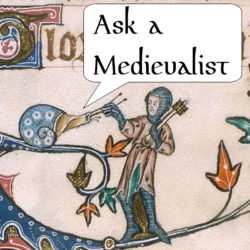Synopsis
From Bisclavret to Remus Lupin, werewolves have been portrayed in fiction for centuries–and portrayed both positively and negatively, by Jews and Christians alike. Join Em and Jessie as they discuss Medieval legends about these amazing beasts. And also a little bit about golems, kappas, and zombies/revenants, plus other creepy facts.
Annotations and Corrections
1/ Jesse, we have to save some monsters for next year’s episode. [There are always plenty of monsters! We haven’t even started.–JN]
2/ The children’s book Jesse is thinking of may be The Book of Hob Stories, by William Mayne. [Yes! It’s a whole series.–JN]
Jesse: A Midsummer Night’s Dream (Shakespeare) II.i, the First Fairy to Puck:
Either I mistake your shape and making quite,
Or else you are that shrewd and knavish sprite
Call’d Robin Goodfellow: are not you he
That frights the maidens of the villagery;
Skim milk, and sometimes labour in the quern
And bootless make the breathless housewife churn;
And sometime make the drink to bear no barm;
Mislead night-wanderers, laughing at their harm?
Those that Hobgoblin call you and sweet Puck,
You do their work, and they shall have good luck:
Are not you he?
3/ If we haven’t linked to it before, Daniel Radcliffe’s letter to the Trevor Project is here.
4/ The basilisk was discussed in episode 2 (see note 12).
Jesse: The Winter’s Tale (Shakespeare) I.ii, Polixenes to Camillo:
Make me not sighted like the basilisk:
I have look’d on thousands, who have sped the better
By my regard, but kill’d none so. Camillo,–
Also, while we’re on names, Harry Potter, and Shakespeare–Hermione is the very long-suffering wife of the jealous King Leontes in The Winter’s Tale (which precipitates the above dialogue between Polixenes and Camillo). In Greek mythology, Hermione was the daughter of Helen of Troy and Menelaus, King of Sparta (so, when Helen went off to Troy with Paris, she left her daughter Hermione behind).
Wikipedia has pictures of Kappas if you’re curious. [In reading this Wikipedia page, I realized that kappa maki, a sushi roll containing rice and strips of cucumber, is named for the folkloric Kappa, which are said to like cucumber and are often given offerings of the same.
I just need to pause a moment to gather in the fragments of my mind.–Em]
5/ Werewolves, not swearwolves.
[10:30] “Be careful when you meet people in Harry Potter…” I feel like a solid grounding in classical languages would be pretty important in that world. Actually a little weird that Hogwarts didn’t have a Latin (Greek, Hebrew, Aramaic, …) teacher…
Fenrir, child of Loki.
For the Terry Pratchett book with the support group for shy banshees and reluctant zombies, see Reaper Man. One of the zombies (Reg Shoe) eventually becomes a recurring character in the various Night Watch books as well. [Yes, I think the support group is for the “differently alive.”–JN]
The main Terry Pratchett books with golems are Feet of Clay, Going Postal, and Making Money, although like Reg Shoe they tend to turn up in the background of various others of the books.
The Ted Chiang short story about golems is “Seventy-Two Letters,” and it can be found in his first collection, Exhalation.
The X-Files episode with golems is “Kaddish” (season 4, episode 15).
6/ Yod-hay-vav-hay: it doesn’t spell out “Jehovah” in Hebrew because of grammar. (I think I had the Tetragrammaton mixed up in my head with some of the elements of the plot of “The Nine Billion Names of God,” by Arthur C. Clark. Honestly, I think that says something about how I have typically approached religion, somehow. –Em)
7/ For liminality, see episode 18, note 8.
8/ The Hereford World Map can be found in episode 11, note 21 and episode 14, note 21.
9/ Puck’s list, which immediately follows the First Fairy’s question above (II.i):
I am that merry wanderer of the night.
I jest to Oberon and make him smile
When I a fat and bean-fed horse beguile,
Neighing in likeness of a filly foal:
And sometime lurk I in a gossip’s bowl,
In very likeness of a roasted crab,
And when she drinks, against her lips I bob
And on her wither’d dewlap pour the ale.
The wisest aunt, telling the saddest tale,
Sometime for three-foot stool mistaketh me;
Then slip I from her bum, down topples she,
And ‘tailor’ cries, and falls into a cough;
And then the whole quire hold their hips and laugh,
And waxen in their mirth and neeze and swear
A merrier hour was never wasted there.
—Midsummer Night’s Dream, act II, scene 1
We also see him drug a bunch of teenagers and turn the head of Bottom the weaver into that of an ass throughout the course of the play, among other things. [College-age kids by today’s standards. Also, while Oberon could certainly be accused of roofying Titania, Puck’s use of the drug on Demetrius raises some really interesting questions–i.e., that some men are loyal to their lovers (Lysander, except for a drug slip up by Puck, whoops), while some men are not (Demetrius). The happy ending of Midsummer depends on Demetrius remaining drugged for the rest of his life, presumably. Poor Helena?–JN]
10/ Jan Potocki is the author of The Manuscript Found in Saragossa. It’s a real cult classic. I don’t know if he’s really known for anything else, honestly, other than his extremely creative mode of death.
11/ Werewolves of London, by the great philosopher Warren Zevon.
[Terry Pratchett also has some great werewolves who are good, bad, and ambiguous, but the main werewolf character is a good female werewolf who is a member of the Watch, Angua.–JN]
Concerning the etymology of werewolf, I wish to direct everyone’s attention to this poem by Christian Morgenstern, translated by Jerome Lettvin:
The Werewolf
One night, a werewolf, having dined,
Left his wife to clean the cave
And visited a scholar’s grave —
Asking “How am I declined?”
Whatever way the case was pressed
The ghost could not decline his guest,
But told the wolf (who’d been well-bred
And crossed his paws before the dead).
“The Iswolf, so we may commence,
the Waswolf, simple past in tense,
the Beenwolf, perfect, so construed,
the Werewolf is subjunctive mood.”
The werewolf’s teeth with thanks were bright,
But, mitigating his delight,
There rose the thought, how could one be
Hypostasized contingency?
The ghost observed that few could live,
If werewolves were indicative;
Whereat his guest perceived the role
Of Individual in the Whole.
Condition contrary to fact,
A single werewolf Being lacked —
But in his conjugation showed
The full existence, a la mode.
This translation by Alexander Gross is also great.
A Werewolf, troubled by his name,
Left wife and brood one night and came
To a hidden graveyard to enlist
The aid of a long-dead philologist.
“Oh sage, wake up, please don’t berate me,”
He howled sadly, “Just conjugate me.”
The seer arose a bit unsteady
Yawned twice, wheezed once, and then was ready.
“Well, ‘Werewolf’ is your plural past,
While ‘Waswolf’ is singularly cast:
There’s ‘Amwolf’ too, the present tense,
And ‘Iswolf,’ ‘Arewolf’ in this same sense.”
“I know that–I’m no mental cripple–
The future form and participle
Are what I crave,” the beast replied.
The scholar paused–again he tried:
“A ‘Will-be-wolf?’ It’s just too long:
‘Shall-be-wolf?’ ‘Has-been-wolf?’ Utterly wrong!
Such words are wounds beyond all suture–
I’m sorry, but you have no future.”
The Werewolf knew better–his sons still slept
At home, and homewards now he crept,
Happy, humble, without apology
For such folly of philology.
(The Zwicky site linked above has several other charming translations.)
12/ The board game in which King Cnut makes an appearance. 7.2 is a decent rating but the reviews don’t seem super positive. [Ah well. If you’re interested, check out the OED’s definition of werewolf for the quote from Cnut’s Laws, and check out the “Middle Ages” section of WIkipedia’s “Werewolf” page for a translation.–JN]
13/ Marie de France (flourished 1160-1215), poet at the court of Henry II of England and Eleanor of Aquitaine.
Henry II is known for being Peter O’Toole.
The Aquitaine: In case you were curious, it’s in the south near where France runs into modern-day Spain. The largest city there is Bordeaux.
The Nun’s Priest’s Tale.
Anowa, by Ama Ata Aidoo. Not, uh, not a comedy. [Great play though!–JN]
Gerald of Wales.
14/ Article on Jewish werewolves! By Northwestern professor David Shyovitz “Christians and Jews in the Twelfth Century Werewolf Renaissance,” Journal of the History of Ideas 75 (2014): 521-43.
Wikipedia on the Hasidim of Ashkenaz.
Genesis, 49:27: Benjamin is a wolf, he will prey; in the morning he will devour plunder, and in the evening he will divide the spoil.”
I’m just going to point out that elsewhere in the chapter, Napthali is called “a swift gazelle,” and no one has written that he’s a weregazelle or anything, presumably because that’s not really a thing. So the preexisting tradition of people turning into wolves probably works in Benjamin’s favor here.
This raises an interesting question we don’t get into in the episode: why is there a pre-existing tradition of people turning into wolves rather than other dangerous animals such as tigers, bears, hippopotami, etc.? I feel like the privileged relationship between humans and dogs has somehow spilled over to wolves, but beyond that I’m not really sure–someone get Alexandra Horowitz on the phone…
15/ Elijah was assumed into heaven in 2 Kings. This is also the chapter where Elisha, who was Elijah’s companion and in a really bad mood, calls out two bears to tear apart 42 children who are teasing him for being bald. Some might call that an overreaction.
Enoch is assumed into heaven in Genesis 5:24. Unlike Elijah, there’s not much there.
If you are saying, “But wait, back in the episodes about Dante and Hell you mentioned that Christian belief is that no one went to heaven before Christ’s death, and yet here are two people that Christians seem to believe…went to heaven…before Christ’s death,” yes, you have pointed out an interesting doctrinal problem. It’s not clear to me how this is solved, except by the pope basically saying, “Yeah, G-d can make exceptions if He wants to.” [The fact they didn’t die seems to be the key. If you died, you had to wait in Limbo for Jesus to open Heaven.–JN]
16/ Christina the Astonishing was previously discussed in episode 9 (see note 29 and relevant part of the episode). I (Em) would say she’s seriously one of the weirdest stories we have talked about on this podcast, and we have talked about quite a lot of weird stories. [Yay!–JN]
17/ Thriller. [Since MJ is dead, we can acknowledge the genius of this video. It is the best.–JN]
Warm Bodies is the zombie romantic comedy movie mentioned.
18/ Nancy Caciola, Afterlives: The Return of the Dead in the Middle Ages. Cornell University Press, 2016. Amazon link.
Matins happened sometime between 3am and dawn.
19/ The ST:TNG episode I mention was Night Terrors (season 4, episode 17). In it, the corpses sitting up is explained as a hallucination caused by lack of REM sleep (which is another actual thing).
“The Fall of the House of Usher,” by Edgar Allan Poe.
Caitlin Doughty (Ask a Mortician) addressed a story about a woman who woke up alive at a funeral home recently.
It turns out it wasn’t a podcast–it was a New Yorker article: “What Does It Mean to Die?”
Recently (10/19/20): “Michigan Woman Found Alive at Funeral Home Dies 8 Weeks Later“
Podcast: Play in new window | Download
Subscribe: Spotify |








